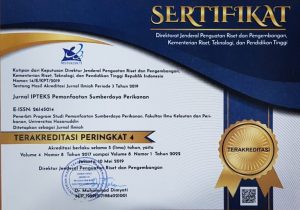Perbandingan Struktur Ukuran Tuna Madidihang (Thunnus albacares) yang Tertangkap pada Rumpon Laut dalam dan Laut dangkal di Perairan Selat Makassar
DOI:
https://doi.org/10.20956/jipsp.v1i2.67Abstract
Yellowfin tuna (Thunnus albacares) has long been captured by commercial fishery in Makassar Strait using purse seine, trolling line and handline fisheries. It was probably it can cause over exploitation and decrease population structure for that fish. This study aimed to analyze the size structure of yellowfin tuna based on the positions of deep and shallow sea FADs (fish aggregating devices). The data consisted of fish length and weight ) and the size of gonad maturation, which were collected from the field observation . The data were analyzed using histogram graph and t- test. The results indicated that the fish length caught in the deep and shallow sea FADs ranged from 30 to120 cm with the average of 101.39 ± 2.49 cm, and from 105 to 170 cm with the average of 134.90 ± 1.90, respectively. The fish weight ranged from 20 to75 kg for deep sea FADs and ranged from 0.4 to 35 kg for shallow sea FADs. The first stage of gonad maturation on either female or male occurred at 118.88 cm forklength, where the smallest spawning size on female was 126.10 cm forklength.














